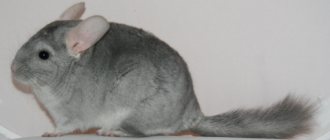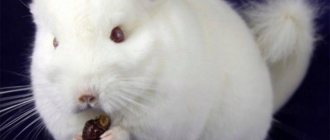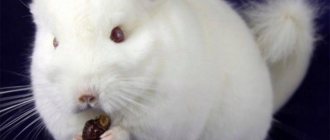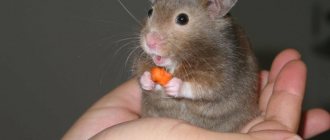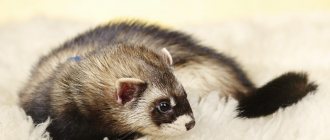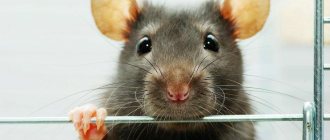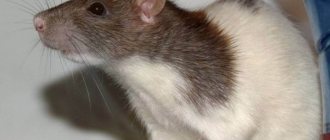03/24/2021 11,445 Chinchillas
Author: Olga
So that the chinchilla could survive in its natural habitat, nature gave it fur of modest colors. The most recognizable color of a chinchilla's coat is white on the tummy, gray on the back and sides. This is the basic color, the so-called standard. Shades from light ash to graphite are the framework within which this gray classic is designed. The breeders decided to change the scenario of nature and the chinchillas themselves, as they were a century ago.
[Hide]
Chinchilla breeds
These domesticated rodents are divided into two varieties with characteristic body structure and tail length:
- Large, short-tailed Peruvian chinchillas come to us from Bolivia and Argentina. These places are their homeland, and there they live in the wild, but only in protected areas, because local residents exterminate them for their valuable fur. In addition to nature reserves, they are also bred in specialized farms. Short-tailed chinchillas not only have thick, fluffy fur, but also a rather massive trunk. Standing on their hind legs, the animals reach a height of up to 40 centimeters and weigh about 800 grams. The tail of large rodents is short and covered with coarse, short hair.
- Coastal long-tailed chinchillas are common in Chile. They have a small body and a long tail covered with thick fur. Their weight does not exceed 700 grams.
Both chinchilla breeds are light gray in color. However, thanks to the efforts of breeders, long-tailed chinchillas now boast a huge variety of shades of their magnificent fur.
Angora chinchilla
One of the subspecies of animals with a long tail is the Royal Angora chinchilla. It was not artificially bred. The rodent appeared thanks to the efforts of nature itself.
This animal was first spotted in the 1960s. However, it was included in the breed catalog only in 2001. Raising this subspecies in artificial conditions is extremely difficult, since the male and female chinchillas of this breed do not always produce long-haired children, and often have short hair. For this reason, the breeder is required not only to be professional, but also to carefully select pairs for breeding the Angora breed.
Angels have silky, long fur and a bushy tail. They also have long hair on their head and paws. The muzzle of this breed of chinchilla is flattened, which is why they are popularly called Persian. The animals themselves are black, blue, diamond and purple in color.
“Angora chinchillas” are the most expensive. The price of one copy is more than 50 thousand rubles. The fur of a pet is so valuable that the high cost of rodents has remained at the same level for more than ten years.”
Dwarf chinchilla
Mini chinchillas are also a natural genetic mutation. These animals have a small body, short legs and a bushy tail. The weight of rodents does not exceed 300 grams.
Dwarf chinchilla animals give birth as young as their normal counterparts, so childbirth is difficult. In most cases, children do not survive. The animal must be under the supervision of a veterinarian throughout pregnancy. The shades of these adorable little animals can vary.
Kinds
Depending on the length of the tail, chinchillas are classified as long-tailed or short-tailed.
Small long-tailed or shore chinchilla
Under natural conditions, these rodents live in Peru and Chile. Females of this subspecies weigh one and a half times more than males - from 500 to 600 g. The body length of the coastal chinchilla ranges from 20 cm, and the tail adds another 10–12 cm to it. The body has a rounded shape, the head is slightly elongated, oval .
It will probably be useful for you to learn how to make a cage, a hammock, a wooden house for a display case and the display itself for a chinchilla.
The ears of these rodents are large, erect, and have rounded ends. The hind limbs are 2 times longer than the forelimbs. There are 5 grasping toes on the front paws, 4 on the hind paws, and all of them are supporting. The fur is thick and comes in different colors, but the back will always be darker than the chest and belly.
This subspecies is most often used as pets.
Important! Since chinchillas have very thick fur and no sebaceous glands, these animals cannot be bathed in water.
In order for chinchillas to clean their fur, you should put a special bath with fine volcanic sand in their cage.
Short-tailed or large chinchilla
This rodent differs from its long-tailed relative by having a tail that is half as large. The average size of large chinchillas is 30 cm. Adult females weigh on average 800 g, and males - 700 g. The body of the short-tailed subspecies is dense and round. The neck is short, the head is large, hook-nosed, with medium-sized ears and large eyes. There are long whiskers on the muzzle that help the chinchilla navigate in space.
The food of short-tailed animals should always be of high quality, as they can be sensitive to the components of factory food.
What types of chinchillas are there: color options
In their natural habitat, these animals have many enemies, and nature itself took care of their survival, giving them an inconspicuous and inconspicuous gray-brown color. In fact, thanks to the gray color of their fur, these furry animals blend into the rocky terrain around them, thus hiding from predators.
However, since these animals were bred in nurseries and farms, breeders have sought to breed animals with new colors, resulting in animals having white, black and beige fur. Years of breeding have resulted in animals with unusual and interesting colors such as purple, sapphire, white and pink.
What color are chinchillas:
- Gray, also called agouti, is considered the standard color for chinchillas;
- White fur of varying degrees of saturation with inclusions of pinkish and beige tones;
- Brown or pastel, which ranges from light beige to rich chocolate tones;
- Black coat color with varying depth and saturation of shade;
- unusual and original colors such as purple, sapphire and pink.
Important: the colors of these rodents are divided into dominant and recessive. The dominant color is the color that appears immediately after the animal is born. In the recessive variant, the rodent does not have a specific fur color, but carries the gene responsible for a certain shade, and can pass it on to offspring after crossing.
Eating and bathing
Since a chinchilla at home, as in its natural environment, must eat hay, it will need an additional feeder for this ingredient.
For a full life and beautiful fur, chinchillas need a bath. The chinchilla bathes in special sand made from crushed volcanic stone. This procedure is necessary for the animal to clean its fur.
You should not use regular sand for bathing chinchillas, because it will damage the animal’s fur.
The bath cannot be kept in the cage all the time; it must be left for half an hour; this time is enough for the animal to perform the procedure, otherwise the chinchilla’s skin will become dry.
Since the process of bathing chinchillas is very interesting, a transparent bath or an ordinary three-liter jar can be an ideal option for observing this cute animal.
Another rule for keeping chinchillas is related to the fact that chinchillas are primarily rodents, therefore, like all rodents, the animal has an instinct that requires gnawing something.
In addition, the cage should contain wooden sticks or toys, as well as mineral or chalk bars that the chinchilla will happily chew on.
Standard gray color of chinchillas
The gray coat is characteristic of both wild and domestic chinchillas. But depending on the shade and depth of color, the gray standard is divided into moderately dark, light, medium, dark and very dark.
Light
Rodents of this color are characterized by light gray fur with a silvery sheen. The belly, chest and paws are pale, almost white.
Average
This is the most typical and common fur color of these animals. The animals have a coat of a uniform gray shade, but a lighter color on the stomach, legs and chest.
Dark
These animals have a gray-black coat with a blue tint that is lighter in color around the belly and chest.
Moderately dark
Chinchillas have a dark gray coat with ash shades on their paws, face and sides. The coat on the belly is blue and white.
Extra dark
The animal's fur is gray, fading to a lighter shade on the sides and chest. The belly is light beige.
Rules of care
When you decide to get a chinchilla, you must take into account that the room in which it will live must meet certain requirements, first of all, it must be warm, light and dry, and the animal also needs good ventilation.
The most suitable temperature for chinchilla health is 18-20°C.
The cage should be equipped with wooden shelves for the animals to rest. The width of the shelves should be 15 cm.
If desired, the cage can be equipped with ladders and tunnels. The cage must have a house in which the animals can rest and have offspring. The bedding in the house needs to be constantly changed.
The house should have the following dimensions: length 30 cm, depth 15 cm, height 15 cm, the house should be twilight.
A ceramic or iron feeder and drinker are attached to the wall of the cage or mounted on the door.
Breeds with white fur
White chinchillas look elegant and familiar. They have their own nuances.
Albino
These animals are not identified as a separate breed. An albino is an animal that, at the genetic level, lacks color pigment. He has milky fur and red eyes.
White Lova
A representative of an interesting variety of chinchillas is White Love. It has a white color with a cream tint. He has beautiful dark ruby eyes.
White-pink
It is created by crossing white and beige individuals. The coat is pure white, the fluff on the ears is soft pink, and the eyes are a darker shade. Sometimes a white-pink mosaic is found, in which case snow-white spots of irregular shape appear on the pink back. A characteristic feature of this color are light freckles on the pink ears.
Did you know that these animals began to be used as a source of valuable fur at the end of the 19th century. Since one fur coat required more than a hundred skins, clothing made from such fur was considered the most prestigious and expensive.
So, in the 20s of the last century, for one chinchilla coat in the German Empire there were about 500 thousand gold marks, and in the 90s in America - more than 20 thousand dollars.
White mosaic
Unlike silvered specimens, these animals have distinct gray patches evenly distributed throughout their fur. The ears and beard are dark, the paws and tail are light, and the back has a light gray veil.
White ebony
This appears as a deep black dust on the snow-white coat. The dust is rich in color on the head, ears, paws and base of the tail.
We recommend reading about other rodents you can keep in your home.
Sometimes localized spots appear on the sides. Sometimes the base may have a light beige tint instead of white.
White velvet
These rodents wear a nice, light, velvety coat that can be beige or silver. It is characterized by distinctive gray spots on its front legs and head.
What to wear with a chinchilla fur coat in the 2021-2022 season
But if you become the owner of a chinchilla fur coat, the question involuntarily arises of what to wear with a chinchilla fur coat.
- First of all, it is necessary to exclude other accents, leaving this right to the fur coat.
- There is no need to add complex fur design; simple and brief additions will suffice. This model will serve as an excellent clothing option for a weekend evening or special occasions.
- No less stylish is the use of such a model with a casual ensemble, for example, with jeans and a beautiful pullover.
Coco Chanel said that truly luxurious things should be “only” for fun and always a little sloppy.
[Total: 4 Average: 2.5/5]
Animals with beige fur
The main shade of these rodents is pastel. However, it has several variations. In addition, the older the chinchilla, the darker its fur will be. It can be brown, red or beige. This type of rodent can be transverse.
Homobeige
This type of rodent has uniformly colored light beige fur and pink ears. Single dark hair is allowed in this shade.
Heterobeige
These rodents, on the other hand, have irregular colors. The entire coat is beige, the undercoat and tips of the hair are brown. When choosing a chinchilla, pay attention to the color difference between the rest of the body and the belly.
Beige tower
The fur color of these animals ranges from light to dark beige, which is paired with a brown pattern along the spine.
Brown velvet
The main color of the fur of these animals is beige, with a chocolate-colored back and head, and a sand-colored belly.
Wellman beige
The chinchilla has light beige fur, light ears and dark eyes.
Beige Sullivan
These rodents have rich beige fur and red eyes.
Genetic calculator
Chinchilla genetics is an interesting and rather complex science. A large combination of genes and their combinations, dominant and recessive manifestations can confuse even experienced breeders. Therefore, a special genetic calculator for chinchilla colors was developed. The main genes of the parents are entered into the calculator: white, beige, sapphire, ebony, purple, velvet and angora, as well as the degree of manifestation of the genes:
- Present or not,
- Double or not
- Carrier or not,
- Gene shade (from light to dark).
Based on the data obtained, the calculator calculates not only the genotype of the parent pair, but also all possible colors of the offspring and the probability of obtaining them. The calculator is useful not only for beginning breeders, but also for those who want to breed a new color morph or fix a specific gene. You can find a genetic calculator on numerous websites of chinchilla breeders and large nurseries.
Breeds of chinchillas with dark fur coats
Among homoebony with rich black fur, the “black velvet” breed stands out.
Black velvet
The contrast of black and white is always mesmerizing. Furs with a black body and tail combined with a lighter belly look amazing. The stronger the contrasts, the higher the breed's rating.
This variety was developed in the 1960s. It is believed that dark fur indicates the high quality of the breed. Black velvet is distinguished by markings: light stripes on the paws, a charcoal mask, darkened fur on the head. The older the animal, the clearer the characteristics of the breed. Breeders are warned: the gene is lethal. It is forbidden to cross “velvet” animals. This will end badly for women and youth.
Rare breeds
The most expensive chinchillas are distinguished by their rare and amazing coloring. Breeders have developed interesting breeds of animals that evoke genuine emotions.
Beige chinchilla Tower
One of the most common subspecies. The fur color is beige in all possible shades. These rodents are distinguished by a pattern on their backs and beautiful, shimmering fur. The ends of the hair are darker, as is the undercoat. Homo beige chinchillas only come from parents who have a dominant beige gene. Obtaining homo-beige animals is important for color fixation and subsequent breeding. Beige animals can be crossed with any species and color without any restrictions.
Pastel
The basic pastel color is available in several color morphemes:
- Original pastel,
- Pastel velvet,
- Chocolate,
- Homogeneous.
Fur color is all shades of beige. Depending on the shape, it can be sand or straw, or a rich chocolate color.
White Lova
The white catfish color scheme is relatively new and was only discovered in 2002. Fur color is creamy white. Most of them are champagne-colored. They are distinguished from Wilson's chinchillas by their dark ruby round eyes.
Ebony
The original color of ebony is characterized by a special and very bright shine of the coat. Ebony can come in all shades of grey. The most important thing is uniformity of color, dense undercoat and silvery shine. There is also a form of velvety ebony. The ebony gene can be either dominant or recessive.
Violet
Rodent owners have a light lilac coat that contrasts with a white belly. The animals' ears and nose have a purple tint. The unusual coloring is passed on only in the first and second generations. Purple chinchillas mature late and can only mate after a year and a half.
Sapphire
A blue-gray or light blue cape with a graphite veil paired with a white belly and pink ears looks stunning. The eyes are shiny black. Sapphires are one of the most expensive and sought after chinchillas.
Color appears up to 7-8 months. Young rodents with a declared sapphire color are best purchased from specialized nurseries.
White and pink diamond
It is considered a rare animal with a pearl coat and a pink tint. Ears are harmonious pink.
Animals have a lethal gene, so they cannot be mated. They will pair well with rodents with other coat colors.
Blue Diamond
More valuable than sapphires are purebred chinchillas with light blue fur, a metallic tint and dark patterns along the spine and head.
Violet
The fabulous bright lilac trunk fur contrasts with the white belly. There is a purple bandage on the nose and ears.
The color of lavender is passed on through the first and second generations. Rodents reach sexual maturity late. The ability to produce offspring appears at the age of one and a half years.
Dwarf chinchillas
The dwarf chinchilla is not a separate breed. This is a genetic mutation that is either permanent or occurs randomly. The size of dwarf animals is much smaller than that of their ordinary counterparts, and can weigh only 300 grams.
Breeding these ornamental rodents is difficult. Women often experience difficulties during childbirth, and among the offspring there are few viable young people. Small chinchillas can be found in a wide range of colors and color morphs.

